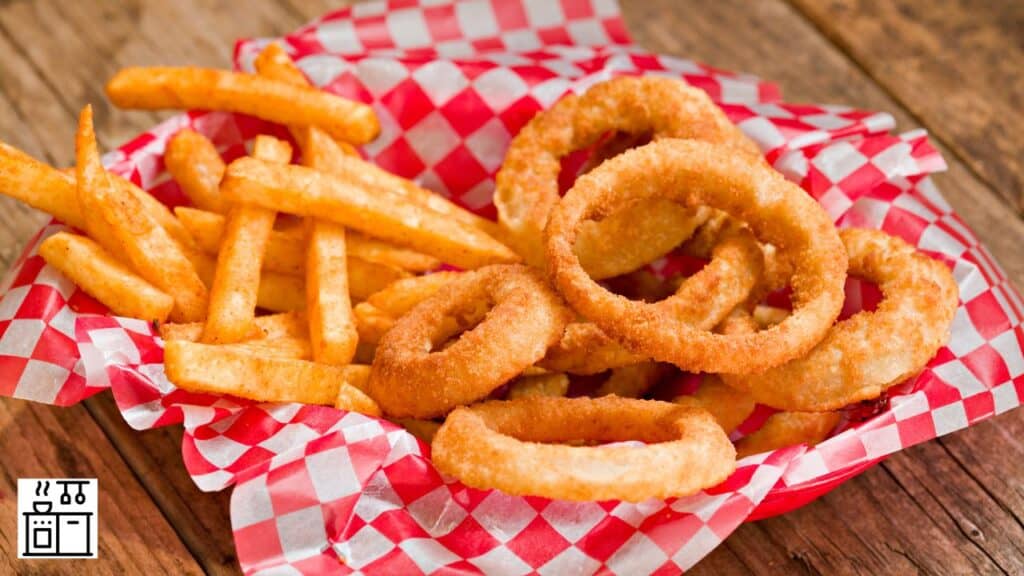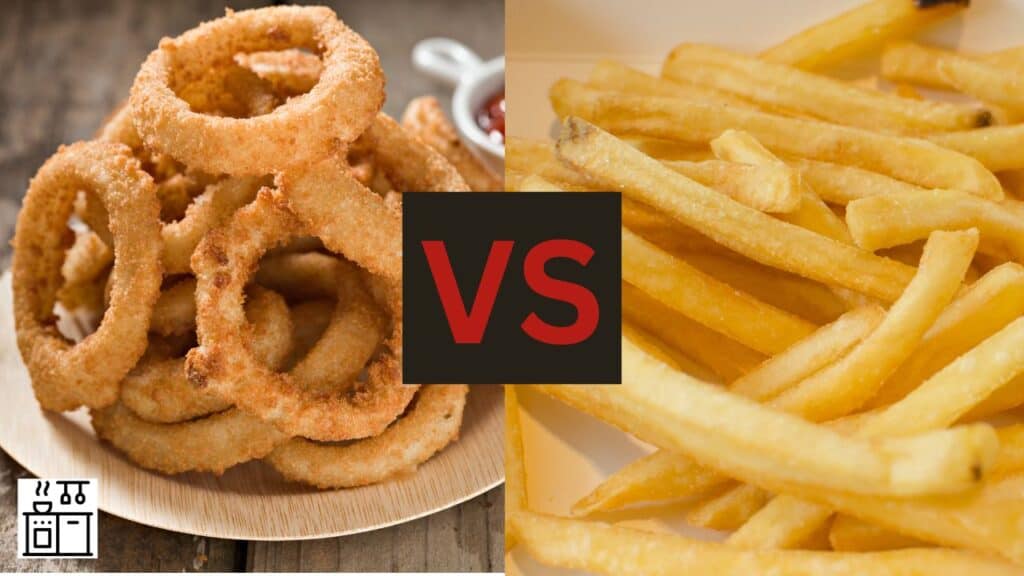Nutritionally, onion rings pack higher levels of vitamin E, calcium, and phosphorus, but they also contain more saturated fat compared to fries. Fries, on the other hand, boast higher quantities of iron, magnesium, potassium, vitamin C, and vitamin K. They also have higher fiber content.
Fries are more common and easier to find, while onion rings are less popular and slightly more elusive.
As for taste, onion rings have a distinctive flavor that can complement various dishes, whereas fries offer versatility and can be paired with a variety of meals.
Intrigued? Ready to finally settle the delicious debate between onion rings and fries?
The ultimate choice will depend on personal preference and dietary needs. However, both onion rings and fries can be savored in moderation, either as a side dish or a snack.
Let’s dive deeper into the history, taste profiles, and nutritional benefits of these two beloved side dishes.
History and Origin of Onion Rings and Fries
Let’s dive into the interesting past of onion rings and fries, exploring where and how they came about.
From their humble beginnings to their place in contemporary cuisine, we’ll uncover the journey of these deep-fried delights.
History and Origin of Onion Rings
It’s fascinating to trace the history and origin of onion rings, from their earliest recorded recipe in 1802 Britain to their widespread popularity in the United States.
You’ll find the first onion rings recipe in John Mollard’s cookbook, where onions were sliced, dipped in batter, sprinkled with Parmesan, and deep-fried in lard. A sauce of melted butter and mustard added the final touch.
Although the exact birthplace of onion rings in the U.S. remains a mystery, many eateries, including Kirby’s Pig Stand, claim to be their creators.
The early 20th century saw onion rings gaining traction in America, with mentions popping up in newspapers and ads.
Their popularity soared in the 1950s with the advent of pre-breaded frozen onion rings, which made them a restaurant staple.
History and Origin of Fries
Diving into the history of fries, you’ll find both France and Belgium laying claim to its invention.
Here’s a brief timeline to give you some perspective about the origin of fries:
- Winter of 1680: According to Belgian folklore, locals in Namur start frying potatoes as a fish substitute due to a frozen river.
- 1775: The first mention of fries appears in a Parisian book, providing a French claim to the dish.
- 1795: The first modern French fries recipe is published in a French cookbook, ‘La cuisinière républicaine’.
- Today: Fries are a global sensation, with various serving styles and adaptations worldwide.
Regardless of their true origin, you can’t deny the universal appeal of this crispy, golden delight.
Nutritional Value of Onion Rings and Fries
Let’s now talk about what you’re really getting when you indulge in onion rings and fries.
It’s time to compare and contrast the nutritional values of onion rings and fries, shedding light on what’s behind the taste you love.
Nutritional Value of Onion Rings
A serving of onion rings typically contains around 304 calories and 18 grams of fat.
But don’t let these numbers scare you because it’s all about portion control and moderation.
Here’s a breakdown of the nutritional values of a serving of 6 onion rings:
- Calories: A serving contains around 304 calories. That’s nearly 15% of a 2000-calorie daily diet.
- Total Fat: At 18 grams, it’s a significant chunk of your recommended daily fat intake.
- Saturated Fat: With 3.6 grams, it’s not insignificant but still manageable.
- Protein: Unfortunately, onion rings aren’t high in protein, with just 3.7 grams in a serving of 8-9 rings.
Nutritional Value of Fries
A medium serving of fries (about 4.1 ounces or 117 grams) has 365 calories, 17 grams of fat, and 48 grams of carbohydrates.
However, it’s not all about the numbers; the nutritional content can vary based on how they’re prepared and the type of potato used.
Fries can also pack a vitamin punch, providing valuable amounts of vitamin C, B6, and K. But remember, moderation is key as fries can be high in calories and unhealthy fats if overindulged.
Here’s a brief table to compare the nutritional content of fries:
| Nutrient | Quantity in Fries |
|---|---|
| Calories | 365 |
| Fat | 17g |
| Carbs | 48g |
| Vitamin C | Yes |
| Vitamin K | Yes |
Taste and Texture of Onion Rings and Fries

Now, let’s talk about the taste and texture of onion rings versus fries.
Taste and Texture of Onion Rings
Onion rings have a distinctive balance of crunchiness and sweetness.
Their golden-brown exterior, achieved through deep-frying or baking, provides a satisfying crunch. The inside of an onion ring, however, remains tender and subtly sweet, a delightful contrast to the crispy outside.
Let’s take a deeper look into what makes onion rings stand out:
- Cooking Process: The frying or baking process of onion rings decomposes propanethial oxide in the onion, creating a slightly sweet taste.
- Texture: The outer layer of onion rings is crunchy, while the inside is tender. This gives a unique contrast in every bite.
- Dipping Sauces: Onion rings can be enjoyed with various sauces, enhancing their flavor.
- Versatility: Onion rings pair well with beef, chicken, and fish dishes, making them a versatile side option.
Taste and Texture of Fries
The taste of fries is influenced by the type of oil used for frying and the seasoning added after cooking.
Striking a balance between a crunchy exterior and a light, fluffy interior of fries can be tricky. But when it’s achieved, it’s nothing short of potato perfection.
Overcooking can make fries tough while undercooking can result in a pasty or gummy texture.
Russet potatoes are often chosen to make fries because of their starchy, low-moisture qualities that prevent sogginess.
Fries take on a whole new flavor when served with condiments like ketchup, mayonnaise, or vinegar.
Popularity and Availability of Onion Rings and Fries
Have you ever wondered about the popularity and availability of onion rings and fries?
It’s an interesting topic, considering how these two food items have captured the taste buds of people worldwide.
Let’s see how prevalent onion rings and fries are and how you can get your hands on them.
Popularity and Availability of Onion Rings
Onion rings aren’t as readily available as French fries. You can find them in a variety of restaurants, yet they aren’t common.
The reasons for this may vary, but here are four possible factors:
- Popularity decline: Over the past year, onion rings’ popularity has decreased by 37.3%.
- Consumption rate: On average, they’re consumed only 1.43 times annually.
- Limited fast-food presence: While some chains like A&W have onion rings on their menus, they aren’t a mainstay everywhere.
- Frozen food aisle competition: Even though brands like Ore-Ida and Great Value offer frozen onion rings, they face stiff competition from other frozen sides, including fries.
Popularity and Availability of Fries
Fries are practically everywhere, with Americans chowing down an average of 34 pounds of fries each year.
You can find them in quick-service restaurants, institutional outlets, full-service restaurants, and fast-food vans. Even some hotels offer them on their menus.
Your local grocery store likely stocks frozen fries in brands like McCain and Great Value.
The global French fries market size hit around USD 25.5 billion in 2022, and it’s predicted to grow at a CAGR of 6.40% between 2023 and 2028.
Onion Rings or Fries – Which One Should You Choose?
It’s a tough call to choose between onion rings or fries because both have their unique attributes and fans.
So let’s break it down based on the following factors:
- Origin: Fries have been around since the 1680s in Belgium, making them a long-standing favorite. Onion rings, on the other hand, originated from a British recipe in 1802. However, their newer status doesn’t make them any less delectable.
- Nutrition: Onion rings offer a good source of vitamin E, calcium, and phosphorus, but they’re higher in saturated fats. Fries provide more iron, magnesium, potassium, and vitamins C and K, plus a higher fiber content.
- Availability: If you’re looking for convenience, fries are the winners. They’re easily found at most fast-food joints, while onion rings might need a bit more hunting.
- Taste: This one’s subjective. Onion rings offer a unique flavor that pairs well with various dishes, while fries are versatile and can complement a wider range of meals.
Ultimately, the choice between onion rings and fries comes down to personal preference.

